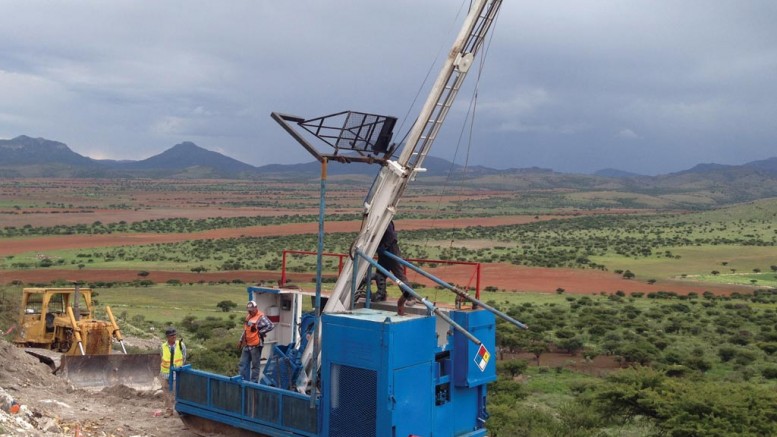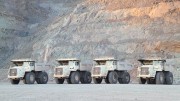Southern Silver Exploration (TSXV: SSV; US-OTC: SSVFF) likes to think that its Cerro las Minitas silver-lead-zinc project in Durango, Mexico, has a lot going for it.
Not only is it close to significant deposits — some of them producing mines and owned by some of the industry’s biggest names in the precious metals space — but the junior has also caught the eye of the Electrum Group, a privately owned, natural resource investment management company founded by billionaire Thomas Kaplan.
Electrum is earning a 60% stake in the project and already owns 46% of the junior’s shares. The New York-based investment group is well-known for its investments in the mining sector, which over the years have included NovaGold Resources (TSX: NG; NYSE-MKT: NG), NovaCopper (TSX: NG; NYSE-MKT: NG), Wellgreen Platinum (TSX: WG; US-OTC: WGPLF), Victoria Gold (TSXV: VIT) and Kaminak (recently acquired by Goldcorp [TSX: G; NYSE: GG]).Southern Silver also has an illustrious pedigree of its own, with a track record in Mexico.
Lawrence Page, who founded Southern Silver Exploration, was a director of Western Silver Corp. when the company was advancing the Penasquito project before its 2006 merger with Glamis Gold, which was later acquired by Goldcorp. Penasquito, 227 km east of Cerro las Minitas, is Mexico’s largest gold producer.
“We got Penasquito to the stage where it really became interesting to Glamis Gold and to Goldcorp, and shareholders of Western Silver ended up with a $1.2-billion payday, if you look at the value of their share appreciation going through Glamis into Goldcorp,” Page says.
“Penasquito was a big home run for shareholders, and we wanted to see if we could emulate it again, using the same geologists and directors.”
The dream team Southern Silver put together for its exploration work in Mexico consisted of three geologists with impressive credentials: Thomas Patton, Adrian Robles Salazar and Roger Scammell.
It was Patton who, as president of Western Silver, had arranged for the company to acquire Penasquito from his former employer, Kennecott. Robles Salazar had worked with Patton at Penasquito while both men were at Kennecott, and was hired by Southern Silver as its country geologist for Mexico, and introduced the company to the Cerro las Minitas property (where he also drilled the discovery hole). Scammell joined Southern Silver’s board in 2002 after leaving Teck Resources (TSX: TCK.B; NYSE: TCK), where he and his team found the San Nicolas VMS deposit, in the Mexican state of Zacatecas. Scammell was Teck’s country manager for Mexico from 1992 to 2002, and under his direction the company also discovered the El Limon gold skarn in Mexico’s Guerrero state, which is now owned by Torex Gold Resources (TSX: TXG). The El Limon-Guajes mine started commercial production in March and according to Torex is one of the world’s richest open-pit gold mines in the world, with a resource grade of 2.65 grams gold.
Cerro las Minitas, which means “a hill of many mines,” is an area made up of artisanal workings. The orebody is centered around the Cerro las Minitas outcrop, which pokes out of gravel. Page and his team put together a claim package of 25 lineal kilometres, and acquired most of it from a Mexican national.
The project has a prestigious area code. Contiguous to Cerro las Minitas east is Hecla Mining’s (NYSE: HL) producing San Sebastian mine, while 28 km west is Coeur Mining’s (NYSE: CDE) La Preciosa project. Fourteen kilometres south are two producing mines owned by Avino Silver & Gold Mines (TSXV: ASM; NYSE-MKT: ASM), and 133 km north is the Pitarillo project owned by Silver Standard Resources (TSX: SSO). Southern Silver completed its US$4 million earn-in for 100% of Cerro las Minitas in 2015 with the help of Freeport-McMoRan (NYSE: FCX), which was interested in the property because its geologists said that a copper-gold porphyry lay underneath the outcrop at depth. Freeport spent US$5 million earning into the project before abandoning the option in 2014, and leaving Southern Silver with all the data.
“We were lucky having Freeport assist in providing money to purchase the property,” Page says. “They drilled a couple of deep holes and they also did some airborne electromagnetic surveys and ground surveys, got some values — but not enough to convince them to stay. There still might be a deep porphyry under there, and we’ll look for it one day, but it’s expensive, so we’re drilling at a more shallow level and we’re into metallics.”
Since 2011, Southern Silver has drilled 91 core holes totalling 35,955 metres and identified a cumulative strike length at Cerro las Minitas of 1,000 metres and up to 600 metres deep. Other work includes surface geochemical and biogeochemical sampling, airborne magnetics and induced-polarization and gravity geophysics.
In March, it completed the first resource estimate on the project. The company reported that the indicated resource based on two deposits — the Blind zone and El Sol — stands at 3.7 million tonnes grading 305 equivalent grams silver per tonne (90 grams silver per tonne, 0.05 gram gold per tonne, 2.3% lead, 2.5% zinc and 0.1% copper), for 36.5 million contained oz. gold-equivalent. The resource estimate used a cut-off grade of 150 grams per tonne silver-equivalent.
The inferred resource — which includes a third deposit on the western side of the central intrusion called the Santo Nino zone — measures 6.6 million tonnes grading 363 grams silver-equivalent per tonne (82 grams silver, 0.17 gram gold, 1.6% lead, 4.3% zinc and 0.2% copper), for a total of 77.25 million contained oz. silver-equivalent.
Southern Silver’s goals are to double or possibly triple the resource through further exploration on the property. Last year, drilling in the area of the historic Mina la Bocona mine intersected high-grade sulphides outside of historic mining along the eastern contact with the central intrusion, which the company says is a discovery. (Mineralization at La Bocona was not included in the resource estimate.)
Mina La Bocona was formerly mined by artisanal workers to 220 metres deep. Highlights from Southern Silver’s drilling — 350 metres east of the historic workings — include 7.8 metres grading 13.5 grams gold, 37 grams silver, 2.2% lead and 1.7% zinc. The mineralization at La Bocona is 1.3 km from the Blind and El Sol deposits.
Earlier this year the company identified a 29.5-metre thick zone of polymetallic mineralization about 300 to 400 metres from the Blind and El Sol deposits, at 600 metres deep. “This is an area that we would want to be doing more drilling and where we have high potential to add high tonnage to the resource base,” the company’s general manager of exploration Robert Macdonald says.
“We’ve identified two main target areas to follow up at Cerro las Minitas, and we would look at another 5,000 to 10,000 metres of drilling over the next year on those programs,” Macdonald continues.
“And as we develop some of these other targets we’ll strike a balance between the development of discoveries, and deeper and expansive drilling at Cerro las Minitas itself.”
This year, Southern Silver will focus on soil sampling and rotary air blast (RAB) drilling to test the eastern and western sides of the property.
Page notes that Hecla used RAB drilling at its nearby San Sebastian mine.
“Hecla was able to discover their resource using RAB drilling on a shallow basis,” he says. “It was successful for Hecla, and we think it will be successful for us. And historically, when Kennecott owned Penasquito, that was the exploration tool they used to get to bedrock on a cost-efficient basis, which was a great vector to finding where the mineralization is at greater depths.
“We’re funded and the program is underway to look for targets on the balance of the property,” Page notes. “We have a pretty good idea what we have around the Cerro, and now we want to see what the balance of the property may have.”
Page hopes that Cerro las Minitas will become Electrum’s second producing mine in Mexico, after its Los Gatos project in Chihuahua. Indeed, the similarities that Electrum saw between Los Gatos and Cerro las Minitas prompted them to approach Southern Silver in the first place.
Electrum’s consultant, Larry Buchanan, sold Los Gatos to the New York-based investor group, and recommended that it take a closer look at Cerro las Minitas.
“Buchanan is the one who found the Apex silver project in Bolivia, which was very, very successful for Dr. Kaplan, and he knew about the Cerro property and recommended it to the Electrum people,” Page says. “He also discovered the Los Gatos project in Chihuahua and thought there was a parallel between the Los Gatos property and Cerro las Minitas.”
Electrum’s privately held Sunshine Silver Mining & Refining is advancing the Los Gatos deposit, 128 km south of Chihuahua City in northern Mexico, and is working on a preliminary economic assessment.
“Los Gatos is a bit more of a vein system than what we have at Cerro las Minitas, but we are also looking at a silver-lead-zinc system primarily with very, very good zinc credits, with some precious metal enrichment in gold and copper, as well,” Macdonald says. “These are all similar intrusion-related systems — large systems that have the potential to be developed into tens of millions of tonnes of mineralization in each of the deposit areas.”
Under Electrum’s option to earn 60% of the project, it must spend US$5 million on exploration, and the group has access to capital. In June, Japan’s Dowa Metals & Mining Co. invested US$50 million for a 30% stake in the Los Gatos project.
“It’s a great relationship with Electrum because not only do we obtain capital from them, but they also have human resources from exploration right through to mining that we are able to avail ourselves of at no cost,” Page says.
As for operating in Mexico, Page says, “it’s a good jurisdiction” where Canadian companies have mined for many years, and where one of Southern Silver’s neighbours, Avino Silver & Gold, has operated since the late 1960s.
“Mexico is a good place to be, silver is a great metal to be in right now and you’ve got the zinc side as well, so all of this is coming together,” he says. “We’ve had a long drought from 2008 until now and some people disappeared, but we managed to survive and develop.
“It was difficult, but now it seems like all the components for success have come together, so we think we’ve got a bright future.”
Over the last year Southern Silver’s stock has ranged from 2.5¢ up to 66¢, and at press time traded at 50¢ per share. The company has 79.5 million shares outstanding for a $50-million market capitalization. Management and close associates hold 10% of the company’s shares.





Be the first to comment on "Electrum sees merit in Southern Silver’s Cerro las Minitas"